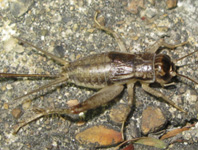Abstract
In this paper we improve the morphological description of the tree cricket Neoxabea brevipes Rehn, 1913 and a new occurrence record for the species at the São Francisco de Paula National Forest Conservation Unit, State of Rio Grande do Sul, southern Brazil. Morphological characterization is provided together with illustrations emphasizing the most significant diagnostic features, such as the metanotal gland, abdominal specializations and phallic sclerites. The calling song was field recorded, comprising a continuous trill with dominant frequency of 3.6 kHz (19.7°C). The karyotype was described for the first time to Neoxabea Kirby, 1906, including diploid number of 2n=26, with two sexual chromosomes.
References
Alexander, R. (1957) The taxonomy of the field crickets of the Eastern United States (Orthoptera: Gryllidae: Acheta). Annals of the Entomological Society of America, 50 (6), 584–602.
https://doi.org/10.1093/aesa/50.6.584
Brown, W.D. (1997) Courtship feeding in tree crickets increases insemination and female reproductive life span. Animal Behavior, 54, 1369–1382.
https://doi.org/10.1006/anbe.1997.0541
Brown, W.D. & Kuns, M.M (2000) Female Choice and the Consistency of Courtship Feeding in Black-horned Tree Crickets Oecanthus nigricornis Walker "Orthoptera: Gryllidae: Oecanthinae). Ethology, 106, 543–557.
https://doi.org/10.1046/j.1439-0310.2000.00569.x
Bruner, L. (1916) South American crickets, Gryllotalpoidea, and Achetoidea. Annals of Carnegie Museum, 10, 344–428.
Cigliano, M.M., Braun, H., Eades, D.C. & Otte, D. (2018) Orthoptera Species File. Version 5.0/5.0. Available from: http://Orthoptera.SpeciesFile.org (accessed 10 July 2018)
Collins, N., van den Berghe, E. & Carson, L. (2014) Two new species of Neoxabea, three new species of Oecanthus, and documentation of two other species in Nicaragua (Orthoptera: Gryllidae: Oecanthinae). Transactions of the American Entomological Society, 140 (1), 163–184.
https://doi.org/10.3157/061.140.0111
Desutter, L. (1987) Structure et évolution du complexe phallique des Gryllidea (Orthoptères) et classification des genres Nétropicaux de Grylloidea. Première Partie. Annales de la Société Entomologique de France, 23, 213–239.
Desutter, L. (1990) Etude phylogénétique, biogéographique et écologique des Grylloidea Néotropicaux (Insects, Orthoptères). Phd Thesis, Université Paris XI-Orsay, Centre d`Orsay, 347 pp.
Desutter-Grandcolas, L. (2003) Phylogeny and the evolution of acoustic communication in extant Ensifera (Insecta. Orthoptera.). Zoologica Scripta, 32, 525–561.
https://doi.org/10.1046/j.1463-6409.2003.00142.x
Johnson, H.H. (1931) Centrioles and other Cytoplasmic components of the male germ cells of the Gryllidae. Zeitschrift für wissenschaftliche Zoologie, 1931, 140–115.
Kitada, S. (1949) Preliminary notes on the chromosomes of Oecanthus indicus. Kromosomo, 5 (6), 227–228.
Levan, A., Fredga, K. & Sandberg, A.A. (1964) Nomenclature for centromeric position of chromosomes. Hereditas, 52, 201–220.
https://doi.org/10.1111/j.1601-5223.1964.tb01953.x
Makino, S. (1932) An Unequal Pair of Idiochromosomes in the tree-cricket, Oecanthus longicauda Mats. Journal of Faculty of Science, Series VI, 2 (1), 1–46.
Milach, E.M., Costa, M.K.M., Martins, L.P., Nunes, L.A., Silva, D.S.M., Garcia, F.R.M., Oliveira, E.C. & Zefa, E. (2016) New species of tree cricket Oecanthus Serville, 1831 (Orthoptera: Gryllidae: Oecanthinae) from Reserva Natural Vale, Espírito Santo, Brazil, with chromosome complement. Zootaxa, 4173 (2), 137–146.
https://doi.org/10.11646/zootaxa.4173.2.4
Morrone, J.J. (2014) Biogeographical regionalisation of the Neotropical region. Zootaxa, 3782 (1), 1–110.
https://doi.org/10.11646/zootaxa.3782.1.1Ohmachi, F.A. (1927) Preliminary note on cytological studies on Gryllodea (Chromosome numbers and sex chromosomes of eighteen species). Proceedings of the Imperial Academy, 3 (7), 451–456.
https://doi.org/10.2183/pjab1912.3.451
Ohmachi, F.A. (1935) Comparative Study of Chromossome Complements in the Gryllodea in Relation to Taxonomy. Bulletin of Mie Imperial College of Agriculture and Forestry, 5, 1–48.
Otte, D. (1992) Evolution of cricket songs. Journal of Orthoptera Research, 1, 25–49.
https://doi.org/10.2307/3503559
Rehn, J.A.G. (1913) A contribution to the knowledge of the Orthoptera of Argentina. Proceedings of the Academy of Natural Sciences of Philadelphia, 65, 273–379.
Walker, T.J. (1962) The taxonomy and calling songs of United States tree crickets (Orthoptera: Gryllidae: Oecanthinae). I. The genus Neoxabea and the niveus and varicornis groups of the genus Oecanthus. Annals of the Entomological Society of America, 55, 303–322.
https://doi.org/10.1093/aesa/55.3.303
Walker, T.J. (1963) The taxonomy and calling songs of United States tree crickets (Orthoptera: Gryllidae: Oecanthinae). II. The nigricornis group of the genus Oecanthus. Annals of the Entomological Society of America, 56, 772–789.
https://doi.org/10.1093/aesa/56.6.772
Walker, T.J. (1967) Revision of Oecanthinae (Orthoptera: Gryllidae) of America south of the United States. Annals of the Entomological Society of America, 60, 784–796.
https://doi.org/10.1093/aesa/60.4.784
Walker, T.J. & Gurney, A.B. (1967) The metanotal gland as a taxonomic character in New World Oecanthus (Orthoptera, Gryllidae). Proceedings of the Entomological Society of Washington, 69, 157–161.
Walker, T.J. (1978) Post-copulatory behavior of the two-spotted tree cricket Neoxabea bipunctata. Florida Entomologist, 61, 39–40.
https://doi.org/10.2307/3494433
Walker, T.J. (2018) Singing insects of North America (SINA). Available from: http://entnemdept.ufl.edu/Walker/buzz/index.htm (accessed 10 July 2018)
Zefa, E. (1999) Autosomal rearrangement in Gryllus assimilis Fabricius, 1775 (Orthoptera, Gryllidae). Genetics and Molecular Biology, 22 (3), 333–336.
https://doi.org/10.1590/S1415-47571999000300008
Zefa, E., Neutzling, A.S., Redü, D.R., Oliveira, G.L. & Martins, L.P. (2012). A new species of Oecanthus and Oecanthus lineolatus Saussure, 1897 from Southern Brazil: species description, including phallic sclerites, metanotal glands and calling song (Orthoptera: Gryllidae: Oecanthinae). Zootaxa, 3360, 53–67.
Zefa, E., Redu, D.R., Costa, M.K.M., Gottschalk, M.S., Padilha, G.B., Silva, A.F. & Martins, L.P. (2014) A new species of Endecous Saussure, 1878 (Orthoptera, Gryllidae) from northeast Brazil with the first X1X20 chromosomal sex system in Gryllidae. Zootaxa, 3847 (1), 125–132.
https://doi.org/10.11646/zootaxa.3847.1.7

